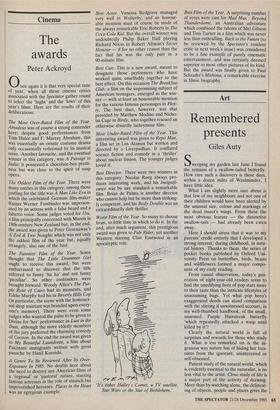Art
Remembered presents
Giles Auty Sweeping my garden last June I found the remains of a swallow-tailed butterfly. How rare such a discovery is these days, within a dozen miles of Westminster, I have little idea.
What I am slightly more sure about is that few of my neighbours and not one of their children would have been alerted by the unusual size, colour and markings of the dead insect's wings. From these the most obvious feature — the distinctive swallow-tails — had already been eaten away.
Here I should stress that it was to my parents' credit entirely that I developed a strong interest, during childhood, in natu- ral history. Thanks to them, the series of pocket books published by Oxford Uni- versity Press on butterflies, birds, beasts and wildflowers formed a major compo- nent of my early reading.
From casual observation, today's gen- eration of eight-year-old readers seem to find the unedifying lives of pop stars more to their taste than the intricate lifestyles of unassuming bugs. Yet what pop hero's exaggerated deeds can stand comparison with the stirring if unwitnessed account, in my well-thumbed handbook, of the small, unarmed, Purple Hairstreak butterfly 'which repeatedly attacked a wasp until killed by it'?
Clearly the natural world is full of surprises and rewards for those who study it. What is less remarked on is the in- genious way nature has of hiding her trea- sures from the ignorant, uninterested or self-obsessed.
Patient study of the natural world, which is evidently essential to the naturalist, is no less vital to the artist. Close study of life is a major part of the activity of drawing. More than by watching alone, the delineat- ing of objects, people and places gives the artist an odd and unique bond with them. Far from breeding contempt, true familia- rity with nature fosters growing affection and admiration.
By regularly drawing his or her environ- ment, the artist not only gets to know it well but generally to like it better. Examin- ing how trees, rocks, clouds, waves — or, for that matter, people — are made, encourages respect, and may prompt mus- ings about the existence of some unifying intelligence. If child vandals drew trees more often they would want to uproot them less. Unfortunately, in most young children's current education, the closest approach to drawing is finger-painting or other modes of inchoate sloshing, de- signed, so educational theorists assure us, to protect the artistic virtue of `expressive- ness' for later life. Paradoxically, licence of this kind often proves inhibiting, not only to little children, but to those who, similar- ly encouraged to express themselves during secondary education, lose all respect not only for their teachers but for art. Of what does the as-yet-unformed self exist, that they should be supposed to be expressing it?
In the realms of further education in art, the anti-drawing lobby for a long time went further still. While scores of life drawing classes were closed down, the view was simultaneously encouraged that all pre- vious traditions of art had become irrelevant. Happily, and not before time, this particular trend has been reversed now in many, if not all, art schools. But such tardy re-assertion of sanity cannot aid or compensate the generation of students who suffered the worst excesses of alternative, `progressive' systems.
Amid the extremes of the Modernist art climate of the Sixties, ambitious profes- sional artists would as soon have owned up to extravagant sexual perversions as to suspicions that they might be secret sketch- ers of the countryside. Altogether, the past 30 years have thrown up some bizarre happenings in the practice and teaching of art. These will have prompted many paren- tal prayers that their own sons and daugh- ters would not find themselves called to the profession. During a Radio 2 debate, quoted in the current Art Monthly, a former rugby international expressed such misgivings in emphatic terms. Asked about the risks of playing rugby, he offered parents the following advice: 'Certainly, I recommend it as a grand way of life to a worried mother or father to send their kids into — at any rate a ruddy sight better than sending him to art school, wouldn't you say?'
Much of the disrepute of art schools has unquestionably been earned. A proportion of ignorant and inattentive students, fre- quently encouraged in the belief that the history of relevant and significant art began no more than 100 years ago; lazy, venal and complacent staff — no wonder these have attracted the attention of an unsym- pathetic and cost-conscious government. In the past five years, we have witnessed drastic cuts in fine art courses and the virtual elimination of part-time lecturing by practising professional artists, tradi- tionally one of the major glories of the British system.
Yet if the art school system's self- inflicted wounds are deep, they should not be allowed to become fatal. Artists will continue to be born for whom proper educational provision should be made in any ostensibly civilised country. Unborn generations should not be forced to suffer for the follies of their forebears. When conducted responsibly and intelligently all the arts clearly have a vital part to play in the nation's health.
This Christmas, I hope many parents will not simply be giving their children presents such as traditional drawing and painting materials, or books on natural history, but also encouraging and helping them in their proper use. These days both gifts have that most welcome potential to open windows onto fresh and deeply satisfying worlds.



















































































 Previous page
Previous page